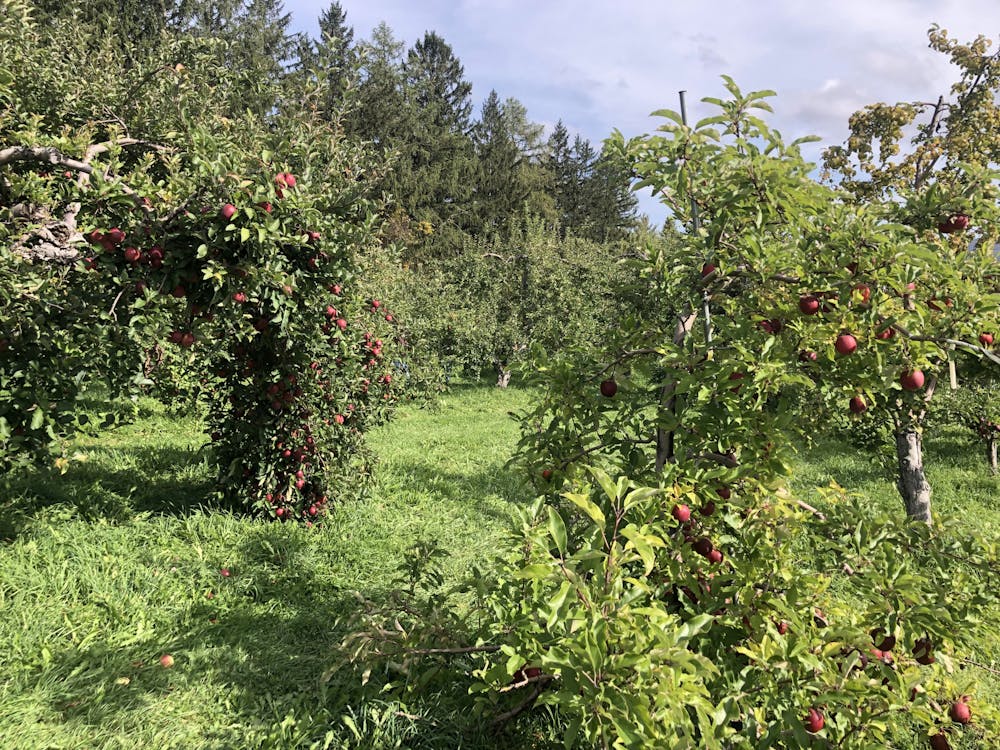The annual apple-picking season — one that ran particularly long this fall — is winding down at apple orchards across Vermont. This year’s season saw near-perfect weather conditions, with mid-October and early November still seeing warm enough temperatures for fruits to thrive, as well as a significant number of apple-pickers — enough for an extended season.
Sophia Rampone, marketing coordinator of Champlain Orchards, explained that the apple-picking season is split into three sections of early, mid and late season apples. The season begins in mid-August, when the early season apples are available to pick.
Late season apples are available from mid-October until the first fruit-killing frost, which is usually seen in early November, Rampone explained. At that point, the apple-picking season concludes, but that doesn’t mean the orchards close.
“We actually stay open year-round as a wholesale business, farm market, and seasonal pick your own with a variety of tree fruits and berries,” Rampone said.
Boyer Orchards, located on 25 acres in Monkton, Vt., saw a similarly long apple-picking season. Mark Boyer, co-owner of the orchard, speculated that the extended season is largely due to both an increase in tourism as well as warmer weather conditions.
“I think Covid has certainly changed that environment a little bit, in that people are more excited to get outdoors, to pick apples, and to be out there,” Boyer said. Apple-picking is largely a pandemic-friendly activity, which has drawn many people to these orchards over the past couple of years.
Boyer also explained how the almost ideal weather conditions play a role in the extension of the apple-picking season. “Early on, we had the warm weather that tends to ripen them up size-wise, and we wait a little bit for some cold weather too to do a little bit of the coloring process,” he said. Cold weather came at the perfect time this season.
The pick-your-own season, in which customers can come to the orchard and pick apples, along with other fruits, from the various trees, officially ended for Champlain Orchards in the second week of November because the orchard picked all the fruit.
“We had to harvest the apples so they didn’t start to spoil on the tree in the weather,” Rampone said.
She also mentioned that Champlain Orchards was able to harvest much more fruit this year.
“We ran out of good fruit to pick rather than good weather to pick it,” Rampone said, noting that this is not typically the case.
Typical fall Vermont operations for Boyer Orchards also include maple sugaring, a process which Boyer mentioned has also seen significant differences in length over the past years due to changing weather.
“I certainly see some major swings there in temperature and changes to sugaring seasons, either lengthening them or shortening them in different years,” he said.
With regard to weather, both the sugaring and apple-picking seasons have seen ideal weather conditions. Last year, Boyer noted that the orchard was open for all eight weeks from mid-August to the beginning of November. This year, despite a few rainy days, largely warm and clear weather has brought out many customers and helped supply an abundance of apples to pick.
Concluding operations involve first picking apples to harvest and then washing and sorting all of them into three “grade” categories: 1st grade apples sorted for resale, 2nd grade sold for utility and baking, and 3rd grade used for sweet and hard cider, as well as apple sauce and compost.
In preparation for the closing, Boyer Orchards prunes all their trees in November.
“The general consensus has been in the past to always prune through the wintertime,” Boyer said. However, he has attributed higher efficiency with pruning earlier in the year.
As Boyer Orchards closes their season, Boyer has noticed that the cold temperatures in November have stunned the apples in some sections of the orchard for the following year.
“So there’s kind of some early winter kill that we’re seeing sometimes,” he said. These drastic temperature swings of, at times, a 20 degree drop, have lightened up some of the apple trees in Boyer Orchards; however, the stunning of the apples has not put too big a dent in the 146 various apple varieties in the orchard.
Once the pick-your-own season closes for the orchards in the winter, the orchards begin to prepare the farm for the colder temperatures. “That ends up looking like winterizing irrigation systems, removing old trees to make room for nursery trees, installing underground drainage tile, digging up nursery trees in late November and plowing fields to prepare for Spring,” Rampone said. Largely, however, orchards remain dormant until the first signs of the apple-blossom season in the spring.

Emily Hogan '24 (she/her) is a Local Editor.
She is studying Environmental Policy with a minor in Math. In addition to writing and editing for the Campus, she also dances with the On Tap dance troupe and serves on the Environmental Council. She has previously worked with the Sustainability Solutions Lab at Middlebury.




